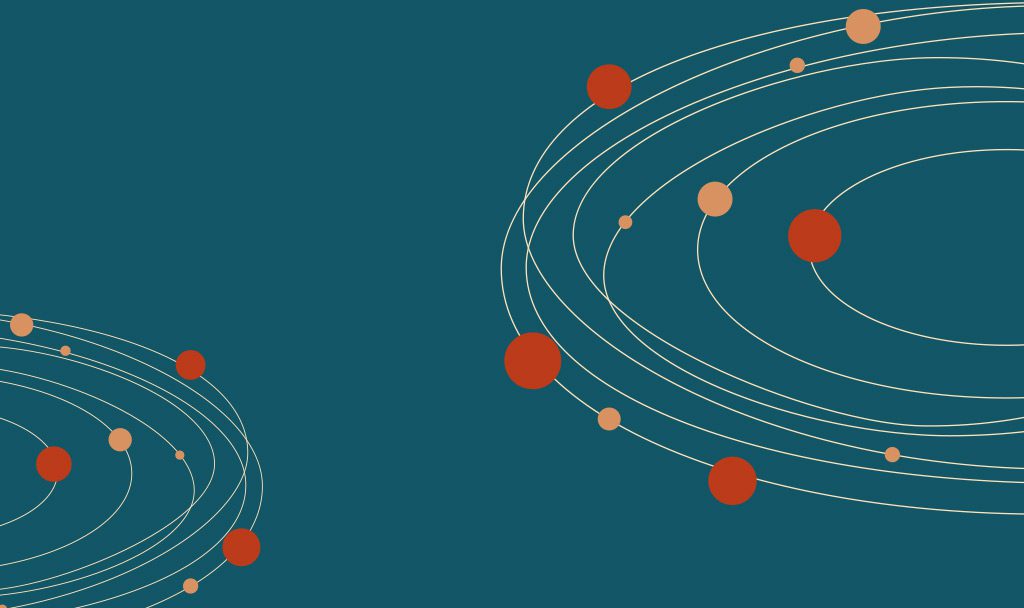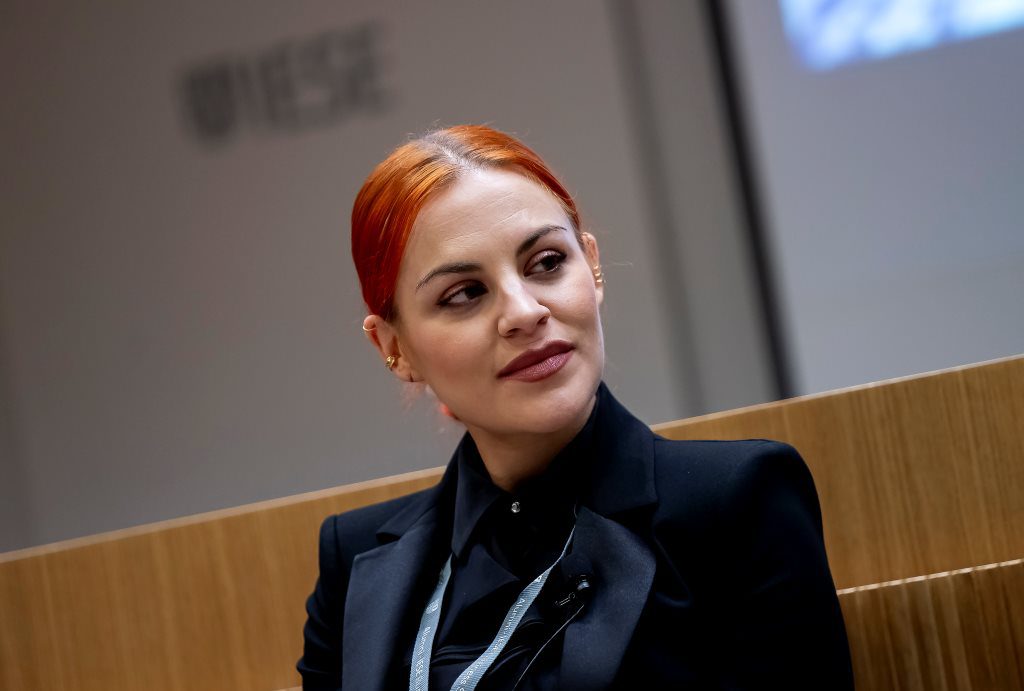
IESE Insight
A stellar challenge: Spain’s first female astronaut Sara Garcia Alonso sees space as a lab for innovation
From the lab to outer space: for biotechnologist and astronaut Sara Garcia Alonso, cancer research knows no frontiers.
As a child, Sara Garcia Alonso played with a microscope and gazed at the stars. Never did she imagine that one day she’d be doing cutting-edge cancer research for a national laboratory and be the first Spanish female member of the Astronaut Reserve of the European Space Agency (ESA).
Garcia appeared at the inaugural #AeroSpaceDay held at IESE Madrid in January 2024, alongside Pedro Duque, the first Spaniard to go up into space and the current president of the telecom and satellite operator Hispasat.
The event was organized by the recently formed Aeronautics & Space Hub of IESE Alumni. It brought together experts and entrepreneurs from the industry to discuss challenges, trends and success stories, like that of Garcia, who has taken her twin passion for molecular biology and space, and made it her life mission — to improve others’ lives.
 Sara Garcia Alonso is the first Spanish female member of the Astronaut Reserve of the European Space Agency (ESA).
Sara Garcia Alonso is the first Spanish female member of the Astronaut Reserve of the European Space Agency (ESA).
A life-changing decision
Garcia graduated with top honors from the University of Leon with a degree in biotechnology, followed by a doctorate in molecular biology, also with honors, from the University of Salamanca’s Cancer Research Center. Although she had always been drawn to space, becoming an astronaut was never top of mind. It wasn’t until 2021, when the ESA put out a call for female applicants, that she ever saw it as a feasible option. By then, she was already working at the Spanish National Cancer Research Center (CNIO) in Madrid, leading new drug discovery research for lung and pancreatic cancer.
“I specialize in targeted therapies, understanding the needs of each patient and offering them individualized treatments,” she says. “If I were chosen to go into space, I would seek to advance precision medicine from the lab of outer space.”
Going up against more than 20,000 other candidates, Garcia felt her chances of making it through the ESA’s rigorous selection process were slim. Still, she figured she had nothing to lose and, in any case, it would be a valuable learning experience: “I’d face situations I wasn’t used to, get to know myself better and hopefully come out stronger. In the end,” she says, “it changed my life.”
Proving her worth
What set Garcia apart? The way she proved herself, says Duque. “When we select people, they must have demonstrated something,” he explains. “Why did NASA choose Neil Armstrong to go to the moon? Because he had been demonstrating his capabilities for a long time beforehand.”
Being an astronaut today is as much about psychology as knowledge. “What you need to know for a space mission will be taught during training,” says Garcia. While being in excellent physical condition is important, “I’m not superwoman. No one is.” The key is having the right set of capabilities.
For each phase of the selection process, Garcia demonstrated the personal and professional skills, abilities and competencies she had acquired through her daily work in the lab, which, as it turns out, are also vital for going to space — not to mention business leadership.
- Interpersonal skills. One reason Garcia believes she was chosen is because the ESA was confident she could handle working for six months at a time in confined quarters with wide-ranging personality types, collaborating constructively with professionals from various fields.
- Focusing energies on the essential. You can’t be the best at everything. In any new situation, the important thing is to grasp the key bits. “You have to assimilate vast amounts of information and identify the relevant parts, quickly, under pressure, all without losing enthusiasm. You have to stay operational and energetic, even with a heavy workload.”
- Managing adversity. In the lab, Garcia faces many high-risk situations, like handling highly toxic materials and complex machinery. “You need nerves of steel,” she says. Like any space mission, lab work requires repetitive training: “I had to learn new procedures and follow strict protocols for adverse situations.” It’s not enough to achieve a high probability of safety; it has to be 100%. The same goes for astronauts, who are put under enormous pressure in scenarios of extreme risk.
- Reacting with calm. The lab isn’t the only context where Garcia has learned how to react fast under pressure. She also practices martial arts as well as skydiving, scuba diving and climbing — activities where the smallest mistake, fear or overconfidence can jeopardize your life. “You can’t let panic or anxiety take over,” she says. “You have to solve whatever problem may arise on the spot.”
Curiosity without limits
All these traits are fueled by the same triple engine: voracious curiosity, setting no limits and a life purpose of contributing to society.
She describes an innate need “to experiment with everything and be everything all at once.” Such hungry curiosity was instilled in her by her parents, both entrepreneurial in their own way (her mother opened her own fabric store and her father had a carpentry shop). “When I asked about magnets, my mother bought me a book about them. When I wanted to experiment, my father gave me a toy microscope and collected samples found on the street. And when we went to the countryside, he took me out to look at the stars with constellation maps.”
Coupled with curiosity was a culture of effort, which her parents taught her should be directed toward things you genuinely like and are interested in. They never pressured her to pursue a scientific career and they always let her make her own mistakes. They just wanted her to be happy — something they reminded her of when she was chosen for the Astronaut Reserve.
And what makes Sara Garcia happy? “To keep learning and contributing to improving the lives of others,” she says. This is where molecules converge with the stars. “I’m very interested in the tasks assigned to astronauts, the type of missions, the science being done and especially the impact it can have on people and countries. That’s what I’m looking for: to undertake ambitious, inspiring scientific projects, to be surrounded by technology and to work in multidisciplinary environments — all with the spirit of adventure that comes with being an astronaut.”
People-focused leadership
In science, robots are fast making inroads, so could there ever come a day when Garcia sees astronauts being replaced by robots? Not likely: “Humans themselves are the guinea pigs,” she says, enabling research on how microgravity affects the human body, such as muscular and skeletal degeneration, leading to advances in the treatment of osteoporosis and other diseases.
Although she sets no limits (“never have, never will”), there have been times when “walls and obstacles” have been placed upon her — for being a woman, for coming from a small town, for her modest family background, for having a certain aesthetic.
Yet she has managed to work these challenges to her advantage. Because she knows what it’s like to be prejudged and has always wanted to be accepted for who she is, she welcomes diverse profiles onto her teams, accepting people, integrating them and not letting conflicts spiral out of control.
Her boundary-breaking background is reflected in her leadership style. To bring out the best in her team, she uses empathy (identifying and managing people’s emotional needs), recognition (listening to everyone’s opinions) and memory (“Remember times when you were treated badly or well to avoid or repeat doing the same to others”). She keeps herself open to new possibilities: “People will only surprise you if you let yourself be surprised.”
All of this informs her holistic view of success: “Each individual success contributes to the success of all.” Or to paraphrase Neil Armstrong, each small step becomes yet another giant leap for humankind.
 Pedro Duque (right), appearing with Sara Garcia Alonso at #AeroSpaceDay held at IESE Madrid, says she has what it takes to be an astronaut.
Pedro Duque (right), appearing with Sara Garcia Alonso at #AeroSpaceDay held at IESE Madrid, says she has what it takes to be an astronaut.
Space as a lab
- Innovative startups. There’s renewed interest in space research, as evidenced by the number of new startups with innovative business models made possible by revolutionary tech advances. Human space exploration is necessary, says Garcia, and must be promoted.
- Space tourism. To what extent does space tourism contribute to medical research? Although tourist missions in themselves may not contribute much, Garcia believes they have spillover benefits. “Private capital accelerates technological development, which can then be applied transversally. The more companies involved, the better conditions we will have, and the cheaper the missions will be.”
- Space agencies. The ESA and NASA, among others, have been conducting missions for years aimed at improving cancer treatments. They study, for example, the amount of radiation an individual can be exposed to and how microgravity conditions accelerate cellular processes and the onset of certain diseases associated with aging. “Understanding such phenomena could help us detect cancer cell vulnerabilities and provide new clues for cancer treatment.”
- Public-private partnerships. PPPs boost science for the wider benefit of society, with some company-funded space experiments yielding promising results. Garcia highlights the case of a pharmaceutical company that funded research on the effects of microgravity on the development of a cancer drug that could replace hours of chemotherapy with a single injection.
The Aeronautics & Space Hub was initiated by a group of IESE alumni to serve as a meeting point for professionals linked to, or interested in, the aeronautics or space industry. To stay informed about, and participate in, upcoming activities and events, join the dedicated LinkedIn group.
Members of the IESE Alumni Association can watch the full session with Sara Garcia Alonso and Pedro Duque, moderated by Diego Rodriguez (IESE PDG ’03), on the IESE Alumni site.
A version of this article is published in IESE Business School Insight magazine #167 (May-Aug. 2024).
READ ALSO: How the pediatric anesthesiologist Carlos Archilla-Cady (IESE Global Executive MBA) has undergone microgravity training with NASA to test eye pressure in a person with active glaucoma.
